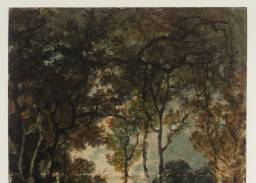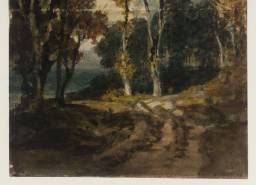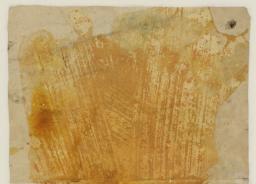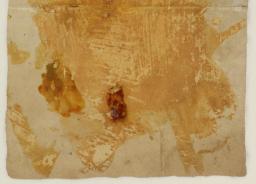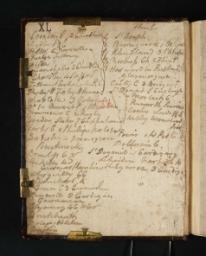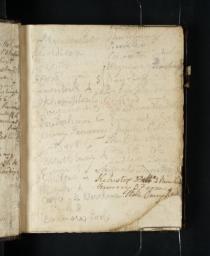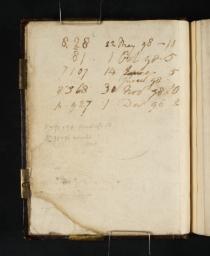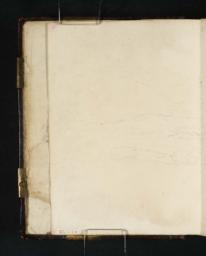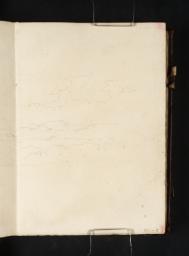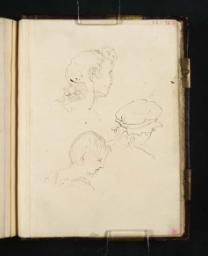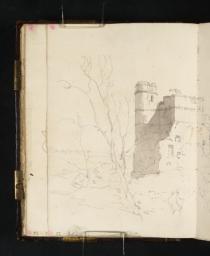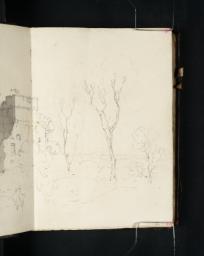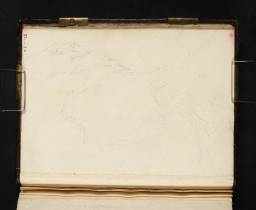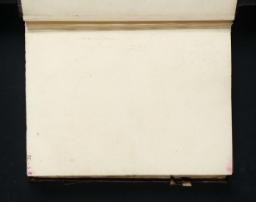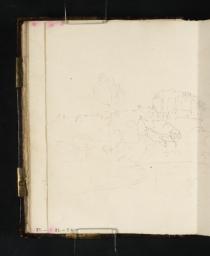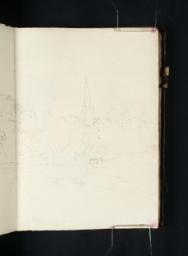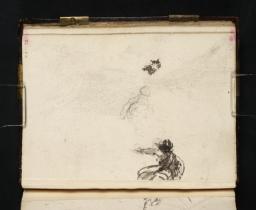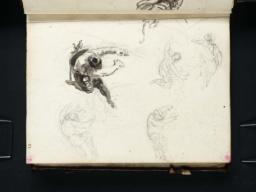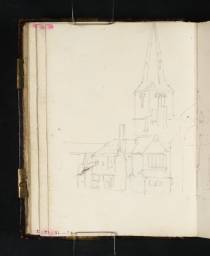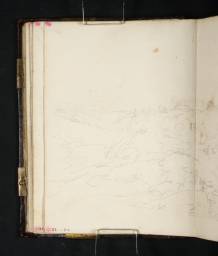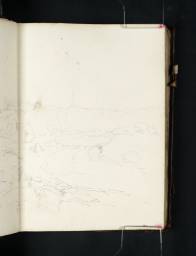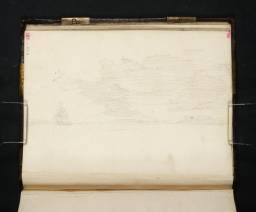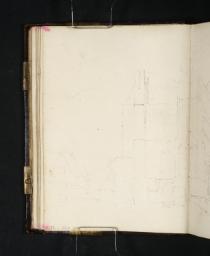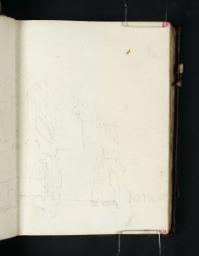Turner Bequest XL 1–96
Sketchbook bound in boards covered in calf leather, with gold-tooled spine and four brass clasps (all broken)
94 leaves, consisting of 91 Whatman wove and 3 flyleaves of laid paper; page size 135 x 95 mm; watermarked ‘1794 | J Whatman’; two further leaves extracted and mounted together (D01627–D01628)
Numbered 380 as part of the Turner Schedule in 1854 and endorsed by the Executors of the Turner inside back cover (D41423)
Blind-stamped with Turner Bequest monogram on outside and inside (D41423) of back cover (otherwise that stamp does not occur)
Inscribed in pencil by Arthur Magyer Hind with notes on rebinding on verso of front flyleaf and inside back cover (D41435, D41423)
94 leaves, consisting of 91 Whatman wove and 3 flyleaves of laid paper; page size 135 x 95 mm; watermarked ‘1794 | J Whatman’; two further leaves extracted and mounted together (D01627–D01628)
Numbered 380 as part of the Turner Schedule in 1854 and endorsed by the Executors of the Turner inside back cover (D41423)
Blind-stamped with Turner Bequest monogram on outside and inside (D41423) of back cover (otherwise that stamp does not occur)
Inscribed in pencil by Arthur Magyer Hind with notes on rebinding on verso of front flyleaf and inside back cover (D41435, D41423)
Accepted by the nation as part of the Turner Bequest 1856
Exhibition history
References
This is one of the five sketchbooks that Turner took with him to Wales in 1798, and used concurrently, though intermittently, with the Hereford Court book (Tate; Turner Bequest XXXVIII). The others are the North Wales, Cyfarthfa and Swans books (Tate; Turner Bequest XXXIX, XLI, XLII). He seems to have taken the book with him on his tour of the previous year to the north of England (see the relevant section of this catalogue), for a few drawings in it appear to have been made at Dunstanburgh, Northumberland; see the North of England sketchbook (Tate; Turner Bequest XXXVIII). It would be tempting to believe that these studies of Dunstanburgh were made in London, on the basis of drawings in other sketchbooks, used in the north; but the sketch on folios 84 verso–85 recto of this book (D01603–D01604; Turner Bequest XL 82a–83) has every appearance of having been drawn on the spot, and, furthermore, does not duplicate the viewpoint of any of the drawings in the North of England book. The 1798 date used otherwise is qualified as ‘?1798’ in these cases.
There are also a group of studies made at Lacock in Wiltshire, presumably for a commission, and sketches relating to historical themes, which make this more than a touring notebook, and bring us into close contact with his efforts to produce significant subject pictures in the first years that he was exhibiting oil paintings at the Royal Academy. Gerald Wilkinson1 suggests that the study on folios 62 verso–63 recto (D01566–D01567; Turner Bequest XL 60a–61), relating to the picture of The Army of Medes destroyed in the Desart by a Whirlwind,2 exhibited in 1801, must date from close to that year. At all events, it is an astonishing drawing, using simple materials with unparalleled force in the suggestion of an immense and Sublime subject.
The ‘backbone’ of the book, however, is the sequence of sketches, many slight, marking the progress of Turner’s tour through South Wales. He travelled west from London to Bristol, stopping at Newbury, and making a drawing of the ruins of Donnington Castle (folios 3 verso–4 recto; D01466–D01467). He crossed the Severn on the Aust ferry, and from Chepstow travelled up the Wye and across to Usk and Brecon, a route undergoing change at the time, since the new Monmouthshire and Brecon Canal was in course of construction. It had been begun the previous year, and incorporated a number of bridges, locks and aqueducts, some of which may figure in Turner’s drawings here. From Brecon he turned south down the valley of the Taff to Merthyr Tydfil, in order to fulfil a commission from Anthony Bacon the younger for views of Crawshay’s Ironworks at Cyfarthfa; see the last page of the contemporary Hereford Court sketchbook (Tate D01249), and the Cyfarthfa sketchbook (Tate; Turner Bequest XLI).
The ‘backbone’ of the book, however, is the sequence of sketches, many slight, marking the progress of Turner’s tour through South Wales. He travelled west from London to Bristol, stopping at Newbury, and making a drawing of the ruins of Donnington Castle (folios 3 verso–4 recto; D01466–D01467). He crossed the Severn on the Aust ferry, and from Chepstow travelled up the Wye and across to Usk and Brecon, a route undergoing change at the time, since the new Monmouthshire and Brecon Canal was in course of construction. It had been begun the previous year, and incorporated a number of bridges, locks and aqueducts, some of which may figure in Turner’s drawings here. From Brecon he turned south down the valley of the Taff to Merthyr Tydfil, in order to fulfil a commission from Anthony Bacon the younger for views of Crawshay’s Ironworks at Cyfarthfa; see the last page of the contemporary Hereford Court sketchbook (Tate D01249), and the Cyfarthfa sketchbook (Tate; Turner Bequest XLI).
Turner had already explored South Glamorgan on his tour of 1795; see the Smaller South Wales and South Wales sketchbooks (Tate; Turner Bequest XXV, XXVI) in the ‘Wales and Isle of Wight 1795–1800’ section of this catalogue. Nevertheless, he continued to Caerphilly and Pontypridd before turning west into the valley of the Towy, which he followed to its estuary at Llanstephan. He then travelled north via Carmarthen and, possibly, Newcastle Emlyn to Aberystwyth, which is the northernmost of the identifiable places drawn in this book, with the exception of Rhuddlan, if that is the castle depicted on folio 47 recto (D01538; Turner Bequest 45). The most elaborate subject is the dramatic coloured study of Carreg Cennan Castle on folios 39 verso–40 recto (D01526–D01527; Turner Bequest XL 37a–38), signalling the pleasure he derived from the wild grandeur of the place, which prompted a number of drawings in the Hereford Court book as well. It is noteworthy that several of the slighter sketches were used as the bases for colour studies of some elaboration (see the later subsection of drawings including those connected with the Kent and Welsh tours of 1798).
Finberg records a ‘Blank parchment label on back’, by which he generally means the spine of a sketchbook (no longer extant). He also notes John Ruskin’s comment on an associated wrapper: ‘380. Early pencil. Valuable for distribution’.3
Technical notes
How to cite
Andrew Wilton, ‘Dynevor Castle Sketchbook 1798’, sketchbook, May 2013, in David Blayney Brown (ed.), J.M.W. Turner: Sketchbooks, Drawings and Watercolours, Tate Research Publication, April 2015, https://www

